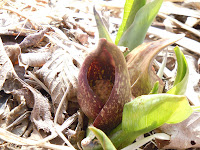At this point I had procrastinated a bit too much and needed to hustle back. But that didn’t stop me from getting distracted along the way. I went by a different route through the same prairie I had entered via. Smack dab in the center is an oasis of sorts. There was a sudden stand of trees, mostly oak (Quercus sp.), that created enough shade for there to be temporary stands of water. While there was no water the at current time
 this fact was evidenced by the plethora of wetland plants beneath the still leafless canopy. How this stand came to be though is somewhat of a mystery to me. It is a fairly large distance to the nearest tree or wetland and while the seeds of the wetland plants could have easily traveled there on their own they could not have survived unless the trees were there to create the shelter that prevented the water from drying up like in the rest of the prairie. One theory I can think of is that the stand was the result of formerly higher water levels of Long Lake which could be supported by the age of the trees. Another possibility is that there was enough runoff of rainwater (carrying with it seeds) from the surrounding dunes and prairie that reached the basin in which our oasis sat before it all soaked into the ground.
this fact was evidenced by the plethora of wetland plants beneath the still leafless canopy. How this stand came to be though is somewhat of a mystery to me. It is a fairly large distance to the nearest tree or wetland and while the seeds of the wetland plants could have easily traveled there on their own they could not have survived unless the trees were there to create the shelter that prevented the water from drying up like in the rest of the prairie. One theory I can think of is that the stand was the result of formerly higher water levels of Long Lake which could be supported by the age of the trees. Another possibility is that there was enough runoff of rainwater (carrying with it seeds) from the surrounding dunes and prairie that reached the basin in which our oasis sat before it all soaked into the ground.As I hit the main road back to the train station I began a forced march/jog back. Along the way I spied three turkey vultures scoping out the land around Loch Long. It was also not far from here that I
 discovered a completely, and I mean COMPLETELY, flattened Beaver (Castor canadensis). Two bad omens in a row? I’m not superstitious but one can’t deny that sometimes phenomena of nature link uncannily with real time events. Case in point: all out of breath and strength, I set foot on the platform the very same moment as the granulated wheels of steel began creeping forward. Luckily there was no one on the platform any more to see me brandishing my staff irately at the back side of the increasingly smaller hunk of shiny metal.
discovered a completely, and I mean COMPLETELY, flattened Beaver (Castor canadensis). Two bad omens in a row? I’m not superstitious but one can’t deny that sometimes phenomena of nature link uncannily with real time events. Case in point: all out of breath and strength, I set foot on the platform the very same moment as the granulated wheels of steel began creeping forward. Luckily there was no one on the platform any more to see me brandishing my staff irately at the back side of the increasingly smaller hunk of shiny metal. Reading over this again I guess it seems like it was a…well…whatever kinda day. No dramatic bird or plant finds beyond personal discoveries of fairly common biota. But the day was profoundly satisfying! I can’t explain it fully. The feeling of just being present in the large open space, of prairie especially, was one of breathless but relaxed joy. It was a beautiful day. Despite the annoying (and somewhat painful in the case of cacti) prickles through the day, it felt great to be out trekking across the sandy landscape.
Thanks for reading! See you on the shifting sands…
Edward Warden






























